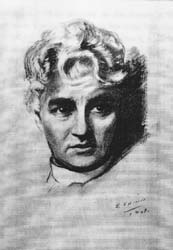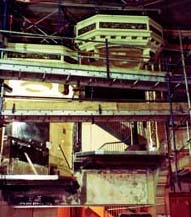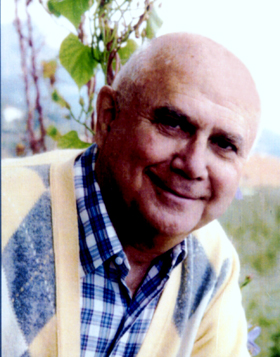
Loney's Show Notes
By Glenn Loney, January 5, 2009. SCALING DANGEROUS HEIGHTS TO RESTORE THE BELASCO THEATRE: FROM TIFFANY TREASURES TO ROMAN CATHOLIC CONFESSIONALS An Online-Holiday-Special from Glenn Loney This is why the current holder of that playhouse-name was opened as Belasco’s Stuyvesant Theatre in 1907, named for Manhattan’s illustrious Dutch-Founder, Peter Stuyvesant. The first Belasco,actually built by Oscar Hammerstein was initially named the Republic Theatre.
Already enjoying success as a playwright, director, & producer, David Belasco was eager to have his own theatre on what was soon to become “The Great White Way.” So, in 1902, he leased the Republic from Hammerstein, making it his own as the Belasco. He was worried that his lease might not be renewed, so he made elaborate plans for a magnificent new playhouse, the Stuyevsant, later renamed the Belasco. [The previous Belasco has, over time, been known as both the Republic & the Victory, reduced during the Great-Depression to showing movies. It is now the New Victory Theatre, remarkably restored by architect Hugh Hardy for seasons of imported productions for children, young adults, & even young-at-heart Seniors.] David Belasco’s intention in making plans for the Interior-Decorations of his new theatre was to make the auditorium & other public spaces like “a Living-Room,” into which he was inviting his friends, the New York Theatre Public. So every aspect of architecture & decoration required the finest of materials & the most noted of artists & artisans. Everett Shinn, of the so-called “Ashcan-School” of artists, devised the extensive Mural-Program.
Tiffany’s Studios designed & executed the many stained-glass lamps & lighting devices, notably the Coats of Arms set into the auditorium ceiling, in which William Shakespeare’s Arms are paired with others, such as Stuyvesant’s! Belasco’s Stuyvesant Theatre’s Cornerstone was laid on 5 December 1906, but Opening-Night was on 16 October 1907. The inaugural drama was A Grand Army Man, starring Belasco-favorite, David Warfield. It dealt with the fate of a Veteran of the Civil War which might offer some historical-resonances for the present fates of our Veterans… On the Program-Cover, this quote: “Give him a handshake as he passes by, he’s a Veteran.” Among the notable actors in the cast were Jane Cowl & the young Antoinette Perry, for whom the Tony Awards™ were later named!
Unfortunately, over the years, the Belasco was sadly neglected, even mis-managed. The colorful Murals were, in some cases, painted-over with a paint-roller. Everything seemed to be deteriorating. Large air conditioning channels were laid in hallways backstage & overhead, even in Belasco’s Private Apartment upstairs.
The Rocky Horror Show, fresh from its London triumphs, where it had been staged in a movie-theatre already in the process of demolition, was very nearly the Nail in the Coffin. The Shubert Management, anxious to be rid of this now undesirable playhouse, decided to visually echo the London production by smashing the lower level of stage boxes on both sides of the Proscenium Arch, which was also damaged. The idea seems to have been that, once savaged, it would be easy to obtain permission to dismantle the theatre & sell its extremely valuable Manhattan Real Estate. The same fate awaited Daniel Frohman’s Lyceum Theatre, one block North of the Belasco. Fortunately, Landmarking saved both these Historic Theatres.
Although The Rocky Horror Show went on to Fame as a Cult Film, it did not last onstage at the Belasco with all the seats ripped out to simulate a Cabaret for more than a few weeks. Fortunately, there was a major Change of Heart in the Shubert Offices. Some of the most delicate of the Belasco’s decorations were put into storage by the newly created Shubert Archive. Efforts were also made to stabilize what remained in place, but the deterioration proceeded. As the Belasco had become an undesirable-showplace, in an undesirable location, it was often rented to productions that the Shuberts judged likely to fail. Sometimes, it was said, such shows were given to space at reduced-rates or rent-free, in hopes that they might, after all, Find Their Audience… Gerald Schoenfeld & Bernie Jacobs, who were court appointed to administer the Shubert Theatres, wisely decided to update & renovate these Historic Properties. If you have recently seen a show in the Shubert Theatre, for instance, you may have noticed how fresh & new all the decorations are, despite their obvious 1920s & 1930s Provenance.
Now the Belasco Theatre itself is finally In Process, to be completed in some nine-months, although many of the Murals look as though it will take much longer to repair & restore them to the “Rembrandt-like” sheen for which they were originally praised. Recently, John P. Darby Vice-President for Facilities of the Shubert Organization showed Richard Hay, Chief-designer for the Oregon Shakespeare Festival in Ashland & Your Scribe through the maze of scaffolding in the Belasco. For many years, I have tried, with many kinds of Zoom lenses, to make close-up photos of the Tiffany Glass Coats of Arms in the auditorium ceiling. Now, at last, I was standing on a scaffold platform that put me just two inches below these
wonderfully cleaned, releaded, & reinforced Tiffany Masterpieces! So, as a Holiday Treat, I’d like to share with readers some of my INFOTOGRAPHY™ photos of this remarkable Work in Progress. This was not easy, as most of the staircases were blocked & the hallways obscured. Not only that: I was just out of Lenox-Hill Hospital with a broken right clavicle, damaged shoulder, & a Subdural Hematoma, which had continued to bleed. So four days later, I was back in Lenox-Hill, with two holes drilled through my skull: Local-Anesthetic! to drain the blood… Years ago, before the Belasco was Landmarked, the late Brooks McNamara took me on an extensive tour of the theatre, including David Belasco’s personal apartment. At that time, one could still go upstairs to Belasco’s bedroom, hung with decorative-landscape-panels on tracks. When the Great Belasco wanted to entertain young starlets, he’d bring them up to admire the Landscapes,
after which the panels could be shoved aside to reveal Erotic-Scenes! This might seem totally out-of-keeping with Belasco’s Public Image as the “Bishop of Broadway,” for he always dressed with a turned-round collar, like a Catholic Priest. He also auditioned stage-hopefuls in his wooden Gothic Confessional. This is still in place & will be restored! Belasco’s Clerical garb was much noted, not only because he was descended from Immigrant Portuguese-Jews, but also because of his often sensual & sensational stagings. These were especially admired, owing to Belasco’s insistence of Accuracy-of-Detail. He achieved On-Stage-Realism, even if the dramatic-fables were Romantic, rather than Real… Two of Belasco’s impressive stage-productions inspired Giacomo Puccini to transform them into operas: Madam Butterfly & La Fanciula del West… Having Made His Name in San Francisco, before coming to New York, Belasco may well have been inspired to stage a near Lynching in Girl of the Golden-West by his own near Lynching as a Horse Thief, when he was a repertory actor at Piper’s Opera House in Virginia-City, Nevada! As for Butterfly, which began as a John Luther Long short story, Belasco may also have been West Coast Inspired. Japan lies just across the Pacific Basin from the Port of San Francisco: Lt. Pinkerton may have set sail for Japan from the Golden-Gate! It’s also curious that San Francisco gave the Broadway Theatre at this time not only David Belasco, but also the Frohman Bothers: Daniel, Charles, & Gus! Meanwhile, the Belasco Restoration goes forward! But the Big Event in February 2009 for those fortunate enough to get tickets from the Shubert Foundation was the splendid Memorial Tribute to the late Gerald Schoenfeld, Guiding Genius of the ShubertTheatres & their often amazing Productions. Hugh Jackman was the adept Aussie Accented MC, introducing a Cavalcade of Stars. An unassuming Lord Webber, formerly Sir Andrew, noted how often Gerry would address him as Cameron, forgetting who had actually created Sir Cameron Macintosh’s fabulous Wealth…
Unfortunately there was no printed Program, so Your Scribe, who stood-in-line cannot now recall all the outstanding actors/directors/dancers/singers/choreographers who sung the praises of a man who really loved the theatre, often propping-up plays he liked but which he knew could never be Crowd-Pleasers! Every Performance Night, he made the rounds of his theatres to see how things were going, knowing everyone who worked for him, even door men & cleaning-staff! Gerry Schoenfeld was also generous with his time & interest in Theatre-Training-Programs in the City, often sharing with our PhD in Theatre Program at the CUNY Graduate Center. He was always available to talk to Your Scribe’s CUNY Seminars, especially about problems of Arts Management! Our association began way back in the 1960s, when our CUNY CASTA Theatre Program Center for Advanced Studies in Theatre Arts mounted an impressive Mall Show in our old home on 42nd Street, across from the New York Public Library & Bryant Park. This was titled 42nd Street: Theatre & The City, celebrating the history of those then-deteriorating Playhouses on what was called “The Theatre-Block.” Once the glittering Heart of Broadway, also known as “The Great White Way” the block itself had become dark & dangerous, the old theatres having lost their Original Franchise during the Great Depression. Instead of glamorous First Nights, there was Minsky’s Burlesque until Mayor Fiorello H. Laguardia shut it down! & Legit Theatres turned into Second Run Movie Theatres. By the 1960s, many were showing Soft-Porn. Our Mall-Show was accompanied by a series of Panels, discussing what could be done to save such Landmarks as David Belasco’s Victory; the Empire, built as The Julian Eltinge for that famed Female Impersonator; the Selwyn, now the American Airlines Theatre, & Florenz Ziegfeld’s New-Amsterdam, original home of the fabulous Ziegfeld-Follies. Your Scribe, as a Prof. of Theatre in the CUNY Program, was Coordinator, along with Dr. Margaret Knapp, who really did all the work… Among Celebrities on our various Panels were the historian Arthur Schlesinger, jr, the drama-critic Stanley Kauffmann, actress Dorothy Stickney, producer Herman Shumlin, the New-Yorker’s Brendan Gill, producer Alfred de Liagre, jr, restaurateur to the Stars Vince Sardi, designer Ming Cho Lee, & Fred Papert, who was spear heading Redevelopment of 42nd Street. There were five panels, examining different aspects of Saving the Theatres. The fifth & last, was chaired by Your Scribe, who had invited Gerry Shoenfeld, Cultural Affairs Commissioner Martin E. Segal, Newsweek critic Jack Kroll, director Wynn Handman, & producer Richard Barr among others, to discuss 42nd Street: Future Showcase of America’s Performing Arts. So much for Future-Visions: Disney & American Airlines are now on Broadway… When it became apparent that there was no Shubert Heir who could continue to operate the Empire created by Sam Shubert & his brother JJ, a NYC Surrogate Judge appointed a Managerial-Troika, headed by the lawyers Gerald Schonefeld, Bernie Jacobs, & Irving Goldman. Goldman has long since disappeared from this Saga, having somehow disgraced himself with Subway Vending-Machines. Schoenfeld & Jacobs, who now have theatres named for them, formerly the Plymouth & the Royale, for those interested in Theatre History saved the Shubert Theatres & even went a long way toward Saving Broadway as well. My relations with Gerry were generally cordial, although there was a Problem with the Lyceum Theatre. This was the Oldest-Broadway Theatre in continuous use as a theatre it was never turned into a Porn Palace! The lovely Neo Baroque Lyceum had been built in 1903 by Producer Daniel Frohman to house his repertory theatre company. What made it special was that for his repertory, Frohman had Costume & Scene-Shops, Scene-Storage, Rehearsal Spaces, & other production amenities on-site, so the theatre complex actually stretched from West 45th Street through to West 46th Street, although in the middle of the block between Sixth & Seventh Avenues. As with David Belasco’s second Broadway theatre, the new Belasco, also between Sixth & Seventh Avenues, but on West 44th Street, Frohman had his own offices & personal-apartment way upstairs in the front of the theatre. Both these producers had small doors in the walls so they could look down & see what was happening on-stage during rehearsals & performances! One day, I heard whispers that the “Shuberts” as Gerry & Bernie were usually called, intended to sell the Lyceum & its Site to a potential Department Store developer. As Stern’s Department Store had recently closed & been rapidly demolished on 42nd Street & Sixth, this seemed a Dumb-Idea for Site-Use. Apparently, the “Shuberts” thought the Lyceum was too small to operate as a commercial Broadway-Playhouse. But how could this Historic Theatre be saved? Not by an appeal to the Shubert-Management certainly… Almost in the same week that I discovered the Plot Afoot, Mrs. Daniel Frohman Davidson, “Uncle Dan’s” Niece, came to my CUNY office to ask my help in getting the Lyceum Landmarked. We soon succeeded in this, which prevented the “Shuberts” from selling the Site & the Theatre. I well understood why they didn’t want to have to “carry” a theatre that was, at least for them, Unproductive. But there was a way to save the theatre, continue to operate it as a Broadway-house, & relieve the Shuberts of their Tax & Maintenance Burdens. This would have been for the City of New York, as had been done with the old Shriners’ Auditorium on West 55th Street, which became the NY City Center during the Great Depression to acquire the Lyceum by Eminent-Domain & then lease the theatre for $1 per-year to the CUNY PhD-Theatre-Program. We could have continued to make possible 8 Broadway Performances a week, but under a quite different contract. We could also have used the auditorium for daytime lectures, panels, & faculty meetings, as all Broadway Theatre Auditoriums are empty even useless most of the day. As Rosemary Harris & Ellis Raab’s APA Phoenix Theatre had been resident in the Lyceum, their ingenious stage-designer, James Tipton, worked out new ways to use the Complex, including an Outside Elevator in the breezeway, to make the usually unsold Balcony easily accessible. Several years before this, the Saviors of South Street Seaport had asked me to find ways to use some of the then derelict 19th Century Buildings in that area. I had written about their problems Fish & Ships, for After Dark Magazine making some suggestions in print. They thought my idea of a John Street Theatre Museum, the John Street Theatre was NYC’s first commercial playhouse, but it no longer exists, was excellent, not only because our first theatre was near the Seaport Site, but also because New York City did not then have, AND STILL DOES NOT, a real Theatre Museum, although it has scattered collections. Hal Prince, Alex Cohen, Alfred de Liagre, & many other Theatre Luminaries supported the Project, which I & my NYU colleague & friend, the late Brooks McNamara, were working out on our own, but without any financial backing up front, or any on the Horizon. [I’ve never been able to Get a Grant for myself, but I have helped others…] Our efforts were applauded, if not assisted. Finally, Hal told me he’d talked with other Broadway Machers about the Idea. They loved it, but it needed to be Mid Town, as “no-one was ever going to go down to South Street Seaport!” [Clouded Crystal-Ball!] At this time, Jimmy Tipton & I were working-out uses for Dan Frohman’s backstage shops & spaces. I thought they would be just right for a Midtown Theatre-Museum, which could be entered through a real Stage Door! We could demolish the rabbit warren of office partitions the APA had constructed in Dan Frohman’s once luxurious office & apartment, restoring them to former Glories. The Upstairs Rehearsal Hall, the same size as the downstairs Stage,could become a CUNY-CLUB, as the City University, unlike Harvard, Yale, Cornell, & even Williams College, has never had a Midtown Center for Fund Raising, Rallies, & pre-theatre cocktails. [It still does not… Why not?] In the event, the Shuberts saved the Lyceum themselves by ripping out some fore stage boxes to install more seats, with bad sight-lines & otherwise improve Income. They also restored Daniel Frohman’s office & apartment, making it the handsome home of the Shubert-Archive, created by my esteemed friend, Brooks McNamara! Happy Ending & no hard feelings between Gerry & me… As far as I know… He never said anything about this to me afterward… But both the Belasco & the Lyceum, as also the Cort, are on the Wrong-Side of Broadway, for some undefined reason less-desirable as Production Venues & not only because they are relatively small… Nonetheless, magnificently restored, the Belasco will now Live Again, shining in its Long Ago Glories! Like the Henry Miller’s Theatre, with its Historic-Façade intact, but a new playhouse inside, just a block south on West 43rd Street, the restored Belasco could well become one of the most lovely of Broadway Theatres!
|









